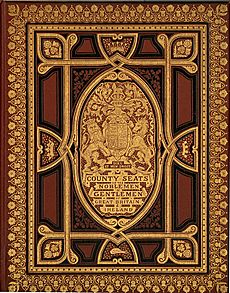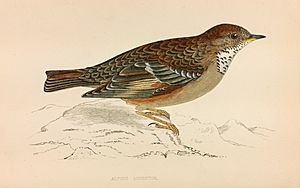Francis Orpen Morris facts for kids
Quick facts for kids
Francis Orpen Morris
|
|
|---|---|
 |
|
| Born | 25 March 1810 |
| Died | 10 February 1893 (aged 82) Nunburnholme, England
|
| Occupation | Vicar |
| Known for | Ornithologist, entomologist, and author |
| Spouse(s) | Anne Sanders |
| Children | 3 sons and 6 daughters |
Francis Orpen Morris (born March 25, 1810 – died February 10, 1893) was an Anglo-Irish clergyman. He was known as a "parson-naturalist" because he studied ornithology (birds) and entomology (insects). Morris wrote many books for children and books about natural history and old buildings. He was one of the first people to campaign for protecting birds from the feather trade. He also helped start the Plumage League. He passed away on February 10, 1893, and was buried in Nunburnholme, England.
Contents
Early Life and Nature Love
Francis Orpen Morris was the oldest son of Admiral Henry Gage Morris. His mother was Rebecca Orpen. He grew up on the west coast of Ireland. This is where he first fell in love with nature and wildlife.
In 1824, his family moved to England. After living in Worcester, they settled in Charmouth, Dorset, in 1826.
Education and Discoveries
Morris went to Bromsgrove School. There, his interest in natural history grew even more. He began collecting birds and insects.
After school, he studied at Worcester College, Oxford. He learned about Classics, including Pliny's Natural History. At Oxford, he met James Duncan, an expert on insects. Morris also helped organize the insect collection at Oxford's Ashmolean Museum.
Life in the Church
In 1834, Morris became a curate at Hanging Heaton. A curate is a helper to the main priest. He was ordained as a priest in 1835.
He worked in several churches across England. In 1844, he became the vicar of Nafferton. He stayed there for nine years. In 1854, he moved to Nunburnholme, where he lived until his death. This new home gave him plenty of time to study nature.
Writing About Nature
While in Nafferton, Morris became known for writing about natural history. He especially loved writing about birds. His first book about British birds was published in 1834.
Around this time, he started working closely with Benjamin Fawcett. Fawcett was a local printer. Their partnership lasted almost 50 years. It greatly impacted how British birds were studied. Benjamin Fawcett was a very skilled printer of colored woodblock prints.
Morris wrote the words for books that Fawcett printed. These books were illustrated by Alexander Francis Lydon. At first, the pictures were colored by hand. Later, they used a special system to print colors from many wood blocks. This was a big change from earlier black-and-white prints.
Many of Morris's books were published by Groombridge & Sons. His first very popular book was A History of British Birds. It came out in parts from 1850 over seven years. Each part had text and four hand-colored pictures.
People loved the book, and more copies had to be printed. Other popular books followed quickly. These included A Natural History of the Nests and Eggs of British Birds, A History of British Butterflies, and A History of British Moths.
Family Life
In January 1835, Francis Orpen Morris married Anne Sanders. They had a large family together: 3 sons and 6 daughters. His youngest child, Marmaduke Charles Frederick Morris, also became an author and took over as Rector of Nunburnholme after his father.
Strong Beliefs and Animal Welfare
Morris was known for having strong opinions. He was eager for new ideas and changes. He strongly disliked fox hunting and any other harm to wildlife.
Views on Evolution
Morris did not agree with Charles Darwin's theories on evolution. Darwin's ideas were explained in his book On the Origin of Species. Morris wrote pamphlets against Darwinism. He believed that ideas like common descent and natural selection were not supported by enough proof. He often asked how natural selection could explain things like a camel's pouch or electric organs in fish.
Protecting Animals
Morris was a strong supporter of animal welfare. He was against vivisection, which is experimenting on living animals. In his book Records of Animal Sagacity and Character (1861), he shared stories that showed animals have "mental abilities." He also believed that animals might have a "future resurrection or restoration."
He wrote other books, like The Cowardly Cruelty of the Experimenter on Living Animals (1890). These books campaigned against cruelty to animals.
Morris was also an early champion of conservation. He worked hard for a law to protect nature, and he succeeded. In 1885, he helped start the Plumage League. This group worked to protect birds. It later joined with another group to form the Selborne Society for the Preservation of Birds, Plants and Pleasant Places. Morris's work helped lead to the creation of the Association for the Protection of Sea-Birds.
Works
- 1834 Guide to an Arrangement of British Birds.
- 1850 An Essay on the Eternal Duration of the Earth.
- 1850 An Essay on Scientific Nomenclature.
- 1850–1857. A History of British Birds. 6 volumes.
- 1851–53 A Natural History of the Nests and Eggs of British Birds. 3 volumes.
- 1853 A History of British Butterflies.
- 1856 A Book of Natural History.
- 1856 Bible Natural History.
- 1859–70 A History of British Moths. 4 volumes.
- 1860 Anecdotes of Natural History.
- 1861 Records of Animal Sagacity and Character.
- 1865 A Catalogue of British Insects in all the Orders.
- 1869 Difficulties of Darwinism.
- 1870 Dogs and their Doings.
- 1870 County Seats of The Noblemen and Gentlemen of Great Britain and Ireland. 6 volumes. online at Internet Archive
- 1875 All the Articles of the Darwin Faith.
- 1877 A Double Dilemma in Darwinism.
- 1880 The Darwin Craze.
- 1886 The Sparrow-Shooter.
- 1890 The Demands of Darwinism on Credulity.



